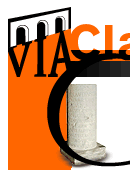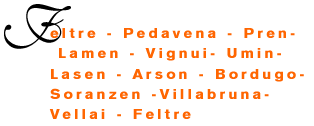|
 p
to 1965 the old Roman route has been always used to reach Vignui
coming from Prèn. Right in Prèn in 1904 excavations brought to light
a fibula, a bracelet and a coin bearing the effigy of the emperor
Massenzio (currently on display in the Archaeological Museum of
Feltre). The Via Claudia went by Vignui and then along the foot
of the mount Pafagai. Once entered the San Martino valley, we reach
the small village "le Buse" : location of the possible bridge crossing
over the stream Stien, about half Kilometre north of the church
of San Martino. The bridge is currently located about 800 m higher
than the presumed original place. In Lasèn, some excavations brought
to light remains of pavement, iron tools, several burial tombs with
bracelets, most of which went lost. In this area there was a Castellum
(according to Alpago Novello it was located 50 m. higher than the
presumed place) of which some spurs have been kept. p
to 1965 the old Roman route has been always used to reach Vignui
coming from Prèn. Right in Prèn in 1904 excavations brought to light
a fibula, a bracelet and a coin bearing the effigy of the emperor
Massenzio (currently on display in the Archaeological Museum of
Feltre). The Via Claudia went by Vignui and then along the foot
of the mount Pafagai. Once entered the San Martino valley, we reach
the small village "le Buse" : location of the possible bridge crossing
over the stream Stien, about half Kilometre north of the church
of San Martino. The bridge is currently located about 800 m higher
than the presumed original place. In Lasèn, some excavations brought
to light remains of pavement, iron tools, several burial tombs with
bracelets, most of which went lost. In this area there was a Castellum
(according to Alpago Novello it was located 50 m. higher than the
presumed place) of which some spurs have been kept.
|
 |
 he
level road reaches Arson, a village where two stones for walnut
oil press have been found (very popular in this area). From Arson
the road may have reached the striking village of Montagne and from
here, uphill and then downhill, to the bridge of Umin, at a point
where it crosses the Caorame (Located slightly above is the nice
village Le Ave with its remarkable church of Sant'Eurosia). Right
in this church, Alpago Novello identifies in the rock cut serving
as a support to the church some remains of the Claudia Augusta.
From le Ave to Bordugo and then uphill to Toschian towards Can. he
level road reaches Arson, a village where two stones for walnut
oil press have been found (very popular in this area). From Arson
the road may have reached the striking village of Montagne and from
here, uphill and then downhill, to the bridge of Umin, at a point
where it crosses the Caorame (Located slightly above is the nice
village Le Ave with its remarkable church of Sant'Eurosia). Right
in this church, Alpago Novello identifies in the rock cut serving
as a support to the church some remains of the Claudia Augusta.
From le Ave to Bordugo and then uphill to Toschian towards Can.

|







![]() Route
Route![]() Route
Route




